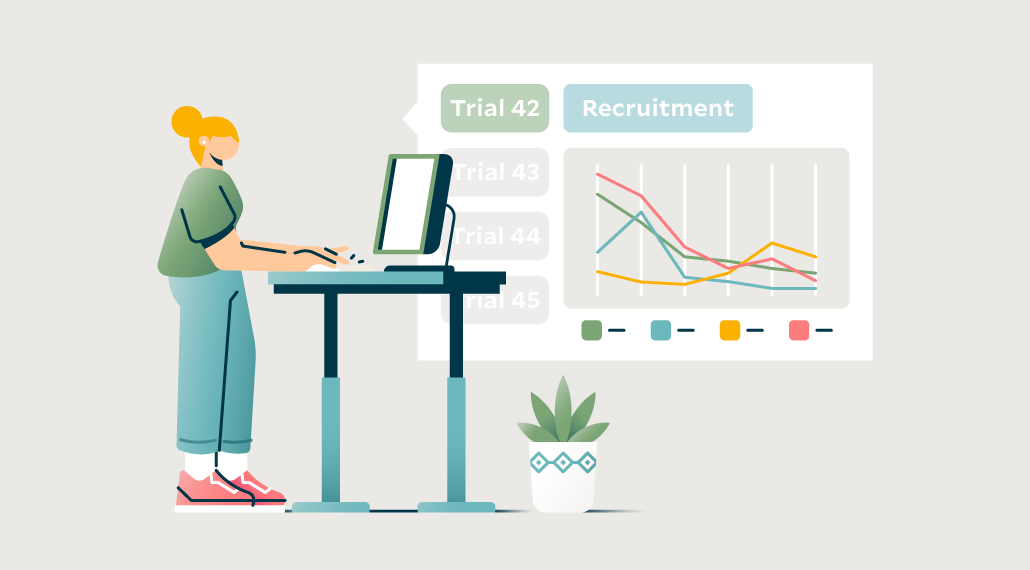August 16th, 2023
3 Benefits of Clinical Trial Enrollment Forecasting
By OneStudyTeam

By Josh Brandoff, Head of Data at OneStudyTeam
In the digital era, here’s a key question clinical trial sponsors should be asking: How do we learn more about our trial trajectory and possible challenges in advance? Too often, sponsors aren’t able to access recruitment and enrollment insights earlier than randomization, which results in course-correcting too late when recruitment and enrollment are off track. The result: lost time, greater expenses, and delayed patient care.
At OneStudyTeam, we use enrollment forecasting in clinical trials to highlight singular risks or risk clusters on a specific trial. With this information, the sponsors we work with can strategize and address (1) challenges and (2) opportunities to support sites earlier before enrollment gets off track.
What is clinical trial enrollment forecasting?
Enrollment forecasting in clinical trials combines study data with machine learning to establish a predictive model that allows you to chart the predicted course of a trial. Such forecasting can be used to identify research sites at particular risk of not enrolling a single patient in the study. With these projections, pharmaceutical sponsors can make assessments and predetermine where to course-correct and how to eliminate barriers for their sites in meeting trial goals.
What are 3 benefits of clinical trial enrollment forecasting for sponsors?
(1) You get insights before trial enrollment gets off track.
With the right data, experts can use machine learning in clinical trials, which trains algorithms to generate predictions about future data. Those experts can then generate an enrollment forecasting report as enrollment is starting up to see where a trial will likely go.
At OneStudyTeam, we offer this report monthly to highlight whether enrollment might be getting off track in a variety of ways. Predictions might show:
- Enrollment goals are unlikely to be met;
- Enrollment goals are likely to be met slowly;
- Certain sites that may have difficulty enrolling patients.
(2) You can act quickly to correct enrollment timelines.
Predictive modeling forecasts risk in a way that’s immediately actionable. It enables trial assessments to inform corrective action in the present, and portfolio assessments to inform how to optimize your trial plan for future trials.
(3) You can work more proactively with your site teams.
Using predictive analytics in your clinical trials to identify enrollment risks can empower you to determine how to provide additional support to site teams, improving relationships and trial outcomes. For example, if enrollment is projected to lag or move slowly, sponsors could work with referral partners to send more potential candidates to the top of the enrollment funnel. If there are geographic clusters of sites that are more likely to enroll at least one patient, sponsors could consider moving faster to launch their trials in those areas.
How does clinical trial enrollment forecasting work?
A patient enrollment management platform (like StudyTeam) can act as a “fusion center” for data, specifically data collected by both sites and sponsors from study startup to enrollment. On the site side, it’s ideal to collect information about patient recruitment sources (which ones are high-performing?) and pre-screening (including diversity data, I/E criteria failures, and reasons patients decline to participate). On the sponsor side, it’s helpful to pull in complementary data (such as IRT/IxRS) to build a complete data foundation.
Once this complete picture of data is available, Bayesian statistical modeling and machine learning can map out two predictions in clinical trials: enrollment risk and enrollment trajectory prediction, respectively.
.png?width=6331&height=3243&name=example-report-enrollment-forecasting%20(1).png)
Enrollment risk models indicate which sites present significant risk to enrollment goals, so sponsors can proactively provide support.
It takes a lot of resources to select and activate sites on trials. If a site enrolls zero patients, sponsor costs can go up and progress toward enrollment goals can stall. But rather than closing these zero-enroller sites, enrollment risk models can empower you to provide better support to at-risk sites to ensure they are able to enroll patients.
Predictive models can pull from site performance history to predict which sites on a trial are at the highest risk of not enrolling a single patient. To ensure ROI for each site, you can use these predictive analytics in your clinical trials to take action, such as prioritizing CRA engagement with high-risk sites and removing enrollment blockers that are identified.
Enrollment prediction models forecast the path trial enrollment will take, so sponsors can analyze the complete picture.
Enrollment prediction offers a bigger picture of risk by visualizing enrollment projections at the trial level. With this added data dimension, you can understand enrollment velocity at multiple scales to determine if your sites and your trial as a whole are on track to meet enrollment goals.
At OneStudyTeam, we use our enrollment forecasting suite to enhance clinical trial predictability through data science.
To achieve our mission of getting therapies to patients sooner, we need faster, more predictable enrollment leveraging digital transformation in clinical trials. That's why we've built an enrollment forecasting engine on top of our StudyTeam patient enrollment management platform. Our enrollment forecasting suite leverages Bayesian inference and machine learning to provide sponsors with a monthly report highlighting study risks and projections over the next 12 months.
This data can be used to build structured assessments of site, funnel, and recruitment performance within and across trials to identify enrollment optimization opportunities and relevant solutions. Assessments and enrollment forecasting for clinical trials are available for all sponsors who use StudyTeam.
Related Posts

How Does a Trial Manager in Greece Improve Clinical Trial Operations with StudyTeam®?
Dimitris Tziogas, local trial manager at a biotechnology company in ...
Read More
How to Address Key Clinical Trial Challenges, According to Clinresco Centres in South Africa
There’s no single solution to overcoming a research site’s specific ...
Read More
3 Clinical Trial Billing Challenges Research Sites Solve with StudyTeam
Challenge 1: Complicated coverage analysis Challenge 2: Tedious budgeting ...
Read More
.png?width=64&name=OST%20Transparent%20(1).png)